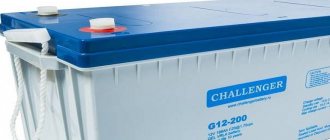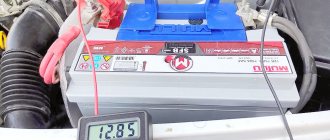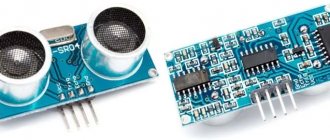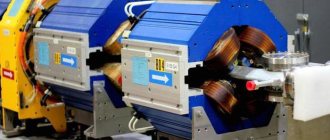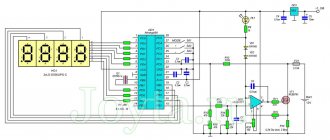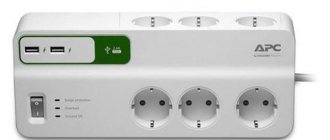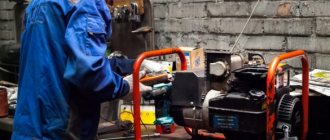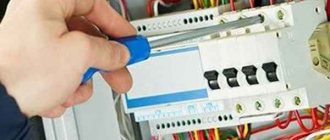An uninterruptible power supply (UPS, uninterruptible power supply) at home can be converted into a variety of devices . For some, you won’t even need the entire UPS, but only its individual components (with or without a housing), so you shouldn’t rush to throw away the old transformer from the uninterruptible power supply, because the device can still find worthy use in everyday life.
How can you use a transformer?
A transformer from an uninterruptible power supply has several application options .
First, as a preparatory step, you should disassemble the device, leaving only the housing and transformer, or make a new housing for the transformer.
Important: The UPS and its components are very often used for purposes other than their intended purpose. They are also used to make voltage converters, chargers, etc., however, these devices, in addition to the transformer, will also require the use of other UPS components (most homemade devices will require a battery).
Use Cases
The simplest and therefore most common option for using an old uninterruptible power supply transformer is to independently manufacture a power supply based on it .
Let's look at the manufacturing instructions, connection diagram and possible problems and nuances.
Connection diagrams and pinouts
The manufacture of a power supply from an old uninterruptible power supply transformer proceeds according to the following scheme:
- using an ohmmeter, the winding with the highest resistance is determined (black and white wires that will serve as the input to the power supply) - when using a device with a standard case, this step is optional, since the socket at the end of the UPS can already be used as an input;
- 220 V alternating current is supplied to the transformer;
- voltage is removed from the remaining contacts;
- a search is made for a pair for which the potential difference is 15 V (white and yellow wires) - future outputs from the power supply;
- the wires form the entrance to the power supply (on one side of the core position);
- The output of the power supply is arranged from the wires on the opposite side using the same principle;
- a diode bridge is installed at the output;
- The contacts of the diode bridge are connected to consumers.
Yes, on the topic “how to protect it from 220V voltage surges?” Cheap uninterruptible power supplies do not provide any real protection. Yes, they can “absorb” some joules, but... in my practice there were several cases when, during a short-term power outage, less than a second, a cheap UPS killed the hardware connected to it: the inverter had already started, but the bypass (passing electricity through) was still did not turn off, and the output was the sum of the socket and the inverter. I don’t know what’s causing it, I’m guessing it’s due to the poor quality of mechanical relays.
Real protection is provided by constant double conversion uninterruptible power supplies, which have no bypass - they always rectify the incoming voltage to a constant 12...192V, and the output is always the voltage from the inverter. In terms of energy efficiency, of course, they lose, but in principle they do not have such a characteristic as “switching time to batteries”. Well, these don’t cost 20 kopecks, and they don’t make them for low power – there’s no point. If something bad comes from the supply network to such an uninterruptible power supply, its rectifier will first burn out. If the rectifier misses something, the surge will be damped by the battery, and the remainder will go to the inverter. The inverter will also likely burn out faster than it will burn out the connected load. Unless something completely indecent comes to the input, more than a thousand volts, to make its way right between the tracks on the board.
And further. In addition to power, the inverter has another characteristic - the shape of the output signal. The cheapest and worst ones give a square or meander signal. Inverters of the class from “bad, but not the best” to “above average” give a step signal, varying degrees of proximity to a sine wave. And only good, expensive inverters provide a “pure sine” signal, which they never forget to mention in the characteristics. But if the signal shape is not mentioned, then 95% that the inverter gives “steps”, and 5% - a meander.
From the square signal, “heaters” work, and hardware with switching power supplies work (all kinds of computers, not cheap chargers). But inductive hardware - electric motors, “heavy” transformer power supplies - do not work, work poorly, or work but get very hot and make unpleasant noise. And from the meander they can even die, because... the passage of a meander through a transformer produces a whole range of high-frequency harmonics for which the load may not be designed. For example, high-frequency harmonics can penetrate electronic control circuits through parasitic capacitances and be regarded as a control signal. (Somehow I’ve already drilled deeper than the declared horizon of “natural science brains”).
Car inverters never produce real pure sine wave! No, maybe somewhere in the USA there are such things, priced at 300 bucks, but not in Russia, where everything is Chinese and cheap. Therefore, do not connect anything that is very dear to you to the car inverter.
Possible problems and nuances
The described process of manufacturing an uninterruptible power supply from a transformer has, however, significant disadvantages . In particular, they are associated with a typical voltage limited at the output to 15 V. When connecting a certain load to the resulting power supply, it should definitely “sag”.
In this regard, it will be necessary to experimentally select the voltage required at the output, which will require certain skills and knowledge, and is also associated with certain risks.
Thus, although it is absolutely easy to make , it is important to have at least basic knowledge in physics and electronics, as well as strictly follow safety precautions, since any work with electricity is potentially associated with serious risks to life and health.
We increase the operating time of the UPS. Battery selection
Autumn is approaching and energy problems are approaching. A completely typical situation is when the heating has not yet been turned on, and all the neighbors begin to heat themselves with electric fireplaces and various heaters, draining the already loaded network. Storms break wires, wires break, equipment is left without power. A life-saving uninterruptible power supply or UPS comes to the rescue. But what to do when a line failure lasts more than an hour, and the uninterruptible power supply exhausts its entire resource in tens of minutes? Increase the capacity of built-in batteries. Today I will tell you how to do this correctly and safely, as well as how to choose the necessary battery using a real example.
Just the other day, a rather trivial but interesting problem arose. A long-existing server rack with a small amount of equipment and an approximate consumption of 250-400 W is equipped with an IPPON Smart Winner Pro 2000 UPS. Its battery life is about an hour, and in the event of a longer power outage, a gas generator installed on the street was manually started. Objective: to ensure a stand's battery life of at least 6 hours at minimal cost.
The conclusion immediately arises to equip the generator with some kind of automatic start system, like this one. The plus is that the cost of such a modification is about 13 thousand rubles, and the minus is that regular maintenance and refueling of the generator is required. The human factor is added, which means the overall reliability of the system is reduced.
The second method, which was chosen for its simplicity and reliability, is to increase the battery capacity. In this case, it is enough to simply increase the battery capacity; fortunately, in this instance, the battery pack is remote and connected with a separate wire. Since standard batteries have a capacity of 9 Ah and are assembled into a 48 V battery, it is enough to replace them with similar gel batteries with a capacity of 40-50 Ah. Since the charging unit is equipped with a forced cooling system, such a load will not be critical and will only affect the battery charging time.
But what about those whose consumption is much higher and the requirements for battery life are noticeably different? For example, a rack is 1-1.5 kW and requires up to 24 hours of autonomy. In this case, the easiest way is to install uninterruptible power supplies for 10 minutes of operation and powerful generators with an automatic start system, which will start 5 minutes after the power is turned off. This whole system costs a significant amount of money, but sometimes the stability of operation pays for it.
I want to consider an intermediate option for a small office or private home when a reserve for a variable load is required, with a peak of 6 kW and an average consumption of up to 1 kW for a long time without external supply. It is possible to add a generator, then the system becomes completely autonomous.
As an uninterruptible power supply for myself, I chose the rack version of the UPS from the MicroART company. Fortunately, this copy worked for enough time and demonstrated trouble-free operation. In addition, it has a wide range of settings, allowing you to save battery life and use them correctly.
Explanation:
All office UPSs use gel batteries, which have many advantages: they are supplied charged, do not require maintenance, and the electrolyte is in a thickened state, which means it will never spill. But all uninterruptible power supplies support increased voltage on the batteries, which allows you to use 100% of the capacity and charge them as quickly as possible. It is precisely the last two points that significantly reduce the service life of batteries, bringing them to the figure of 2-3 years before failure.
I wanted 5-7 years, or better yet 10, without replacing batteries. And here we come to choosing the type of batteries.
AGM batteries
AGM technology uses a porous filler of fiberglass housing compartments impregnated with liquid electrolyte. The micropores of this material are not completely filled with electrolyte. The free volume is used for gas recombination. Sealed, maintenance-free, do not require a ventilated room for installation. AGM batteries work well in recharge mode (buffer mode) with a service life of up to 10-12 years. If they are used in a cyclic mode (i.e., constantly charged and discharged to at least 60% -80% of capacity), then their service life is reduced by almost two to three times. Service life with full autonomy is up to 3 years. Recommended for backup uninterruptible power supply.
GEL
A substance based on silicon dioxide (SiO2) is added to the liquid electrolyte, resulting in the formation of a thick mass resembling a jelly in consistency. This mass fills the space between the electrodes inside the battery. During the process of chemical reactions, numerous gas bubbles appear in the thickness of the electrolyte. In these pores and shells, hydrogen and oxygen molecules meet, i.e. gas recombination. Almost all evaporation is thus returned back to the battery and this is called gas recombination. The separator in gel batteries is also unusual - microporous duroplasty, due to aluminum additives it is highly resistant to aggressive environments, has high temperature stability and mechanical strength; the latter provides high vibration resistance and impact resistance of the structure. In the production of gel batteries, high-purity lead is used - this increases the performance characteristics of the battery several times. Service life with autonomy is up to 4 years, with backup power up to 12 years. Recommended for backup uninterruptible power supply.
GEL and AGM batteries are practically indistinguishable in appearance and have fairly similar characteristics. Further more interesting.
Armored
The basis of the armor plate is a cover (shell) made of non-woven microporous plastic in the form of a series of parallel tubes. The active mass is contained inside the tubes. The current-carrying part of the plate is a rod frame pressed into the active mass, cast from a lead-antimony alloy. The rod frame is injection molded, which eliminates the formation of cavities and other casting defects in the conductor rods, significantly increasing the service life. The microporous shell reliably protects the positive active mass from shedding and sliding throughout the entire period of battery operation. Recommended for full autonomy and/or backup systems. The service life of armored batteries under autonomous conditions is at least 10 years with proper operation (or 1500 cycles of 80% discharges), or 15 - 17 years with backup power. Supplied dry-charged.
Lithium iron phosphate (LiFePo4):
Sealed batteries manufactured using lithium iron phosphate technology. Recommended for full autonomy and/or backup systems. The service life of lithium iron phosphate batteries under autonomous conditions is up to 20 years with proper operation (or 5000 cycles of 70% discharges), or 25 - 30 years with backup power. Supplied complete with BMS. These batteries have a number of important advantages and are the most promising batteries in the world.
Choice
Everything points in favor of Lithium Iron Phosphate batteries (LiFePo4), but the initial investment is quite large, although the advantages are undeniable: no acid, sealed, maintenance-free and the lowest cost of the charge-discharge cycle. Taking into account all the pros and cons, I decided to go with dry-charged armored batteries.
Preparing and assembling the battery
Since the armored batteries that I chose are supplied in 2V cans, and I needed to get 24V, I had to assemble the battery myself from 12 pieces. The first step was filling with electrolyte. The procedure is associated with a health risk, so it is necessary to use protective equipment: glasses or an eye mask, a respirator, rubber gloves, rubber boots. I also added a rain cover in case the electrolyte, which contains acid, spills. It is also best to fill batteries on a rubber or plastic mat so that if the electrolyte is spilled, there will be no traces left on the floor.
To fill the electrolyte, I used this acid-resistant hand pump.
Refilling the battery itself is quite simple, but taking into account 12 cans it takes a lot of time. Soda is in the frame for a reason. From the chemistry course we know that it is much more effective not to wash off the acid with water, but to neutralize it with soda, so for safety reasons it is better to keep an open pack of soda nearby.
After filling the batteries with electrolyte, it is necessary to recharge the battery no later than after 3 hours. The charging procedure itself must be carried out with an appropriate charger with a current of 10% (0.1C) of the battery capacity. For example, if the capacity is 210 Ah, then the maximum charging current should be no more than 21 A. Thick jumpers are used so that they do not become a bottleneck when large starting currents flow. In addition, when current flows through thin wires, they noticeably heat up, which can lead to premature wear of the batteries or a fire. After all, heating the battery from +25 to +35 degrees reduces the battery life by half.
The next step, which makes it possible to turn serviced batteries into low-maintenance or completely maintenance-free ones, was the installation of recovery plugs. The hydrogen released during charging, rising into such a plug, combines with oxygen and flows back into the battery. Before installing such plugs, you need to fully charge the battery and let it sit for several days, since at first there may be increased gas formation, which such recuperators are not designed for. If we neglect this situation, then a sad result is possible: overheating of the recuperator.
As a result, the battery acquired this appearance and will only require a preventive check of the voltage difference between the battery banks once a year, and a check of the electrolyte level once every 6 years. If the voltage of different batteries begins to “scatter”, then it is necessary to carry out an equalizing charge (charge with increased voltage). If the electrolyte level is lower, just add distilled water.
Here is the advantage of such a solution: for sealed batteries (GEL and AGM), hydrogen, despite internal recovery, also slowly evaporates, but it is no longer possible to add water and such sealed batteries have to be thrown away much earlier.
The stored energy of this particular assembly is 5040 Wh, and without any significant losses to the health of the battery, half can be spent. That is, two or three laptops in normal operation can last a day and still have some energy left. If you add to this an external generator or solar panels, the system becomes completely autonomous and will allow you to operate for more than one year.
Conclusion
The inverter with an external battery pack turned out to be larger than a standard compact UPS with built-in batteries, but the almost endless capacity of external batteries allows you to significantly increase battery life. And if the emergency power supply time from the UPS is minutes or tens of minutes, then when using an inverter with external batteries, the battery life is calculated in hours or days.
If it’s interesting, I can compare two devices head-on: the Powercom Smart King SMK-2000A-RM-LCD UPS and the SIN Energy Pro HYBRID MAP inverter with an external battery pack.

